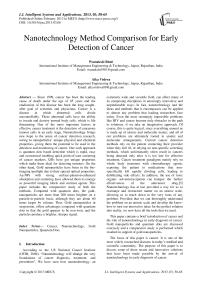Nanotechnology Method Comparison for Early Detection of Cancer
Автор: Wamakshi Bhati, Alka Vishwa
Журнал: International Journal of Intelligent Systems and Applications(IJISA) @ijisa
Статья в выпуске: 3 vol.5, 2013 года.
Бесплатный доступ
Since 1999, cancer has been the leading cause of death under the age of 85 years and the eradication of this disease has been the long sought-after goal of scientists and physicians. Cancer is a disease in which abnormal cells divide uncontrollably. These abnormal cells have the ability to invade and destroy normal body cells, which is life threatening. One of the most important factors in effective cancer treatment is the detection of cancerous tumour cells in an early stage. Nanotechnology brings new hope to the arena of cancer detection research, owing to nanoparticles’ unique physical and chemical properties, giving them the potential to be used in the detection and monitoring of cancer. One such approach is quantum dots based detection which is rapid, easy and economical enabling quick point-of-care screening of cancer markers. QDs have got unique properties which make them ideal for detecting tumours. On the other hand, Gold nanoparticles have been in the bio-imaging spotlight due to their special optical properties. Au-NPs with strong surface-plasmon-enhanced absorption and scattering have allowed them to emerge as powerful imaging labels and contrast agents. This paper includes the comparative study of both the methods. Compared with quantum dots, the gold-nanoparticles are more than 200 times brighter on a particle-to-particle basis, although they are about 60 times larger by volume. Thus, Gold nanoparticles in suspension, offers advantages compared with quantum dots in that the gold appears to be non-toxic and the particles produce a brighter, sharper signal.
Cancer, Nanotechnology, Gold Nanoparticles, Quantum Dots
Короткий адрес: https://sciup.org/15010389
IDR: 15010389
Список литературы Nanotechnology Method Comparison for Early Detection of Cancer
- Pan Y, Neuss S, Leifert A, Fischler M, Wen F, Simon U, Schmid G, Brandau W, and Jahnen-Dechent W. Size-Dependent Cytotoxicity of Gold Nanoparticles[J]. Small, 2007, 3(11):1941-1949.
- Alkilany A M, Murphy C J. Toxicity and Cellular uptake of Gold Nanoparticles: what have we learned so far?[J]. Journal of Nanoparticle Research. 2009, 12(7):2313-2333.
- Ghasemi Y, Peymani P, Afifi S. Quantum dot: magic nanoparticle for imaging, detection and targeting[J]. ACTA BIOMED, 2009, 80: 156-165.
- Chen P C, Mwakwari S C, Oyelere A K. Gold Nanoparticles: From Nanomedicine to nanosensing[J]. NSA 2008, 2008(1):45-66.
- Mousa S A, Bharali D J. Nanotechnology-Based Detection and Targeted Therapy in Cancer: Nano-Bio Paradigms and Applications. Cancers, 2011, 3(3):2888-2903.
- Prajapati P M, Shah Y, and Sen D J. Gold Nanoparticles: A new approach for cancer detection[J]. J. Chem. Pharm. Res., 2010, 2(1): 30-37.
- Tsay J M and Michalet X. New Light on Quantum Dot Cytotoxicity [J].Chemistry & Biology, 2005, 12:1159-1161.
- Cai W, Gao T, Hong H, Sun J. Applications of gold nanoparticles in cancer nanotechnology[J]. NSA, 2008, 1:17-32.
- Zhang H, Yee D, Wang C. Quantum Dots for Cancer Diagnosis and Therapy: Biological and Clinical Perspectives. Nanomedicine 2008, 3(1): 83-91.
- Kumar A, Boruah B M, and Liang X L. Gold Nanoparticles: Promising Nanomaterials for the Diagnosis of Cancer and HIV/AIDS[J]. Journal of Nanomaterials, 2011, 2011:1~17.
- Peng C and Li Y. Application of Quantum Dots-Based Biotechnology in Cancer Diagnosis: Current Status and Future Perspectives. [J]. Journal of Nanomaterials, 2011, 2011:1~11.
- Mansoori G A, Mohazzabi P, McCormack P. Nanotechnology in cancer prevention, detection and treatment: bright future lies ahead[J]. World Review of Science, Technology and Sustainable Development, 2007, 4:226-257.
- Raciot J. Gold Nanoparticles: The Future of Cancer Diagnosis and Treatment[J]. da Vinci’s Notebook. 2010,2:1~2.
- Smith A M, Dave S, Nie S, True L, Gao X. Multicolor quantum dots for molecular diagnostic of cancer[J]. Expert Rev. Mol. Diag.2006, 6(2):231-244.


